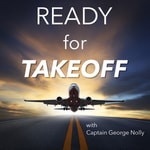Ready For Takeoff - Turn Your Aviation Passion Into A Career – Details, episodes & analysis
Podcast details
Technical and general information from the podcast's RSS feed.

Ready For Takeoff - Turn Your Aviation Passion Into A Career
Captain George Nolly
Frequency: 1 episode/5d. Total Eps: 610

Recent rankings
Latest chart positions across Apple Podcasts and Spotify rankings.
Apple Podcasts
🇺🇸 USA - aviation
03/07/2025#61🇺🇸 USA - aviation
02/07/2025#89🇩🇪 Germany - aviation
01/07/2025#100🇺🇸 USA - aviation
01/07/2025#67🇩🇪 Germany - aviation
30/06/2025#92🇩🇪 Germany - aviation
29/06/2025#85🇩🇪 Germany - aviation
28/06/2025#75🇩🇪 Germany - aviation
27/06/2025#75🇩🇪 Germany - aviation
26/06/2025#55🇩🇪 Germany - aviation
25/06/2025#98
Spotify
No recent rankings available
Shared links between episodes and podcasts
Links found in episode descriptions and other podcasts that share them.
See allRSS feed quality and score
Technical evaluation of the podcast's RSS feed quality and structure.
See allScore global : 48%
Publication history
Monthly episode publishing history over the past years.
RFT 608: D-Day 2024
Episode 608
jeudi 6 juin 2024 • Duration 15:09
D-Day Anniversary
Today is the 80th anniversary of the Normandy D-Day landing. Many of the heroes of the Greatest generation traveled back to Normandy for a final visit. All are over 90 years old, many over 100.
When I was growing up, everyone I knew had a relative who had been killed during World War II. Many of them were killed during the D-Day invasion on June 6, 1944. Operation Overlord was the largest amphibious invasion in history, and was the beginning of the rescue of Europe from the Nazis. It was only the beginning. The war in Europe continued for another 11 months.
I had known that my cousin Herman was killed in Normandy. For years, I assumed he had been killed during the invasion on June 6. Recently, I discovered a web page that covered Herman Cohen’s service, and learned that he had survived the landing at Utah Beach, and was killed in battle 5 weeks later. During the invasion, he was a Private First Class. As senior soldiers were killed, he was promoted to Sergeant.
In the photos on the website, Private Cohen looks like a young kid before the invasion. In the photo taken shortly before his death, Sergeant Cohen looks like a battle-hardened soldier.
Here is the website telling Herman Cohen’s story:
https://delawarewwiifallen.com/2022/01/24/sergeant-herman-cohen/
Many of the soldiers in the landing craft would sign “short snorter” one-dollar bills. They would each pass a bill around to get everyone’s signature on it, hoping to survive with a souvenir.
Every June 6th I go to Youtube to watch the 10-minute D-Day invasion scene in Saving Private Ryan.
RFT 607.1: A-10/Airline Pilot Scott Cerone
lundi 27 mai 2024 • Duration 37:22
Scott Cerone grew up on Long Island, listening to the Concord supersonic airliner fly final approach to JFK Airport, and KNEW he wanted to fly. He attended the United States Air Force Academy, majoring in General Engineering, and went to Undergraduate Pilot Training at Colombus Air Force Base.
Scott ("Hummer") did well enough in training to score an assignment to the A-10 aircraft, and served in combat over Kosovo, the only war that was fought exclusively by air power. Along with other pilots in his unit, he writes about his experiences in A-10s Over Kosovo, available from Air University Press.
Scott has been a pilot at United Airlines for eight years and is a Captain on the B737.
RFT 288: Cancer Survivor/Airline Pilot David Whitson
mercredi 8 mars 2023 • Duration 33:18
From Air Line Pilots Association:
In September 2016, Capt. David Whitson (United) was diagnosed with acute myeloid leukemia, a condition in which white blood cells that manage the body’s immune system form abnormally. The then B-787 first officer was treated at the Texas Oncology–Baylor Charles A. Sammons Cancer Center in Dallas, Tex., where he spent an initial 30 days undergoing tests and chemotherapy.
“I had a mutation called FLT3 that put me at high risk for not reaching remission and also in a high-incidence category for relapse even if remission was achieved,” he recalled, adding, “My best shot was to have a bone marrow transplant, also called a stem cell transplant. Without it, I had a 5 percent chance of survival.”
Whitson was released from the hospital for a brief break. During this period, doctors conducted a bone marrow biopsy and discovered that the pilot’s cancer was in remission, a condition necessary to achieve before a bone marrow transplant could be conducted. Whitson and his doctors quickly found a donor.
“It was hard for me to wrap my head around the fact that a complete stranger would be willing to give me bone marrow stem cells and potentially save my life,” he acknowledged. Whitson endured additional rounds of chemotherapy and a full-body radiation scan to ensure his body was ready and on Dec. 21, 2016, received the transplant. Within several days, his new immune system was up and running.
Thirteen days after the transplant, Whitson was released from the hospital. He noted that prior to the transfusion of stem cells his blood type was B+, but today it’s O-. In addition, the DNA in his blood is different from that in his body.
Whitson encourages everyone to donate blood. “I needed more than a dozen blood and platelet transfusions during my treatments,” he said. The United pilot also urges those interested to join the national bone marrow registry at bethematch.org or www.dkms.org. “There’s a lack of diversity within the registry, and minorities are greatly needed,” he shared.
“Every day is a gift,” Whitson remarked, who credits ALPA’s Aeromedical Office for advising him and helping him jump through the necessary hoops to acquire his special issuance medical certificate and return to the cockpit. He also gave a nod to his medical benefits, noting, “I was on long-term disability for more than two years, and my medical insurance was excellent. Thank you, ALPA!”
RFT 505: Inflight Violence
jeudi 3 juin 2021 • Duration 12:23
A flight attendant on a Southwest Airlines plane lost two teeth over the weekend after allegedly being punched by a passenger who had "repeatedly ignored standard inflight instructions," according to an airline spokesman.
The Port of San Diego Harbor Police Department charged Vyvianna Quinonez, 28, with battery causing serious bodily injury in the incident, which was caught on video and later went viral.
The incident sparked widespread outrage, but for flight attendants it was just the latest example of an increase in travelers becoming disorderly and in some cases turning violent against those tasked with enforcing federal and airline rules.
Southwest Airlines said Friday it would delay its return to serving alcohol to passengers "given the recent uptick in industry-wide incidents of passenger disruptions inflight."
"We realize this decision may be disappointing for some Customers, but we feel this is the right decision at this time in the interest of the Safety and comfort of all Customers and Crew onboard," the airline said in an email.
The FAA is keeping track of attacks
The number of unruly passengers on U.S flights has taken off in 2021, with many more people boarding planes as the pandemic eases.
According to the Federal Aviation Administration, from Jan. 1 through May 24, there were roughly 2,500 reports of unruly behavior by passengers, including about 1,900 reports of people contravening the federal mask mandate, which is still in place.
The FAA has not always tracked unruly passenger reports but began keeping a tally last year as it started to observe a surge in complaints, specifically around noncompliance with the face-covering mandate, said FAA spokesperson Ian Gregor.
"Based on our experience, we can say with confidence that the number of reports we've received during the past several months are significantly higher than the numbers we've seen in the past," Gregor said in an email.
The FAA does, however, keep data on the number of "unruly passenger" violations it has identified. Through May 25, the agency has already recorded 394 potential violations, while in all of 2019 and 2020 there were just 146 and 183 violations, respectively.
Flight attendant unions say the hostility is unprecedented
Sara Nelson, president of the Association of Flight Attendants-CWA, which represents nearly 50,000 flight attendants across 17 airlines, said the level of hostility toward flight attendants is unprecedented.
"We've never before seen aggression and violence on our planes like we have in the past five months," Nelson said in a statement. "The constant combative attitude over wearing masks is exhausting and sometimes horrific for the people who have been on the front lines of this pandemic for over a year."
Nelson said the strained situation is causing some flight attendants to quit.
The surge in unruly passenger complaints is also getting the attention of federal officials, who have warned travelers to be on their best behavior in airports and on planes or risk facing the consequences.
"Let me be clear in underscoring something," Homeland Security Secretary Alejandro Mayorkas said during a Tuesday press conference. "It is a federal mandate that one must wear a mask in an airport, in the modes of public transportation, on the airplane itself — and we will not tolerate behavior that violates the law."
Just this week the FAA announced that it was proposing civil penalties as high as $15,000 against five more passengers for violations that included allegedly assaulting and yelling at flight attendants.
In an open letter, Lyn Montgomery, president of TWU Local 556, the union for Southwest flight attendants, suggested the airline be more consistent in banning unruly passengers and called for an increase in the number of federal air marshals on planes.
From The Points Guy:
There has been a succession of news stories lately about unruly passengers causing trouble in the air during this recent travel surge. U.S. airlines are taking precautionary measures as they’ve witnessed a recent uptick in disorderly passenger behavior.
American Airlines is the latest airline to ban alcohol sales in its economy cabin this summer. According to an internal memo sent to flight attendants on Saturday and first obtained by CNN, economy passengers flying with the airline will have to wait until at least Sept. 13 before they can order a mid-flight drink.
This comes at the heels of the Southwest Airlines announcement that they too are pausing alcohol sales after a flight attendant was physically assaulted in-flight by an inebriated passenger.
In the memo, vice president of flight service Brady Byrnes stated the reasoning behind the airline’s decision:
“Over the past week we’ve seen some of these stressors create deeply disturbing situations on board aircraft. Let me be clear: American Airlines will not tolerate assault or mistreatment of our crews. While we appreciate that customers and crewmembers are eager to return to ‘normal,’ we will move cautiously and deliberately when restoring pre-COVID practices.”
The Sept. 13 date coincides with the federal face mask requirement for airplanes, airports and other modes of transportation that currently runs through Sept. 13.
American was planning to resume full main cabin beverage service, including alcoholic beverage options, as well as its buy-on-board food program later in the summer. However, those plans have now been put on hold.
For now, pre-departure beverage service remains suspended in premium cabins. In the main cabin on flights under 250 miles, non-alcoholic beverage service is available upon request. On flights of 250+ miles, non-alcoholic beverage service with be offered with a snack. “Alcohol will continue to be offered in premium cabins (First/Business class),” according to the memo — but only inflight. American notes that “Pre-departure beverage service continues to remain paused.”
When asked whether or not it had plans to change its alcohol sales policy, Delta Air Lines said in a statement to TPG there are “no changes” to on board services including beer, wine and cocktails for purchase in the main cabin “on most domestic flights.” The spokesperson continued, “Nothing is more important than the safety of our flight crews and customers. And as part of our values-led culture, respect and civility among all are key components of the Delta experience for our customers and people.”
TPG also reached out to United Airlines for comment and will update this post with additional information.
RFT 504: Navy/Airline Pilot Jake Ellzey
lundi 31 mai 2021 • Duration 27:11
Commander Jake Ellzey decided to become a fighter pilot when, at age seven, his dad took him on his first plane ride.
A graduate of the U.S. Naval Academy, Commander Jake Ellzey served as a fighter pilot and completed his service as the Air Boss on the U.S.S. Ronald Reagan aircraft carrier. In his 20 years of service, Commander Ellzey was deployed nine times, including to Afghanistan and Iraq. He served five combat tours by air and one by ground with Seal Team 5.
For his service, Commander Jake Ellzey received two Bronze Stars and eight Air Medals. After retiring from the military, he became a successful local businessman and was appointed by Governor Rick Perry to serve Texas as Commissioner on the Texas Veterans Commission. Today, Commander Ellzey is a commercial airline pilot based out of DFW.
Jake and his wife Shelby are raising their two children on ten acres in Ellis County.
Most Americans look to Texas for the way forward for prosperity and freedom and liberty. Commander Jake Ellzey understands that what happens in Washington DC could threaten all of that. Commander Ellzey is running to bring Texas values and a hometown conservative mindset to Congress. Especially under this new administration, we need tough conservative representation more than ever.
RFT 503: Hijacking!
jeudi 27 mai 2021 • Duration 06:44
Furious Backlash – In what some observers are referring to as “state-sponsored hijacking,” a Belarussian jet forced a Ryanair jetliner flying from Greece to Lithuania on Sunday passenger airliner to land in Minsk so authorities could arrest a journalist on board. The dissident is Raman Pratasevich, a key foe of authoritarian Belarusian President Alexander Lukashenko, who ran a popular Telegraph messaging app that played a key role in helping organize massive protests against Lukashenko.
The government of Belarus used a transparent ruse to justify the operation. According to Associated Press (AP):
Ryanair said Belarusian flight controllers told the crew there was a bomb threat against the plane as it was crossing through Belarus airspace on Sunday and ordered it to land. A Belarusian MiG-29 fighter jet was scrambled to escort the plane in a brazen show of force by Lukashenko, who has ruled the country with an iron fist for over a quarter-century.
The apparent target of the forced landing: Raman Pratasevich, who is “a 26-year-old activist and journalist who ran a popular messaging app that played a key role in helping organize massive protests against the authoritarian leader,” AP reports. “He and his Russian girlfriend were led off the plane shortly after landing — and authorities haven’t said where they’re being held.”
According to AP:
Passengers described Pratasevich’s shock when he realized the plane was going to Minsk. “I saw this Belarusian guy with girlfriend sitting right behind us. He freaked out when the pilot said the plane is diverted to Minsk. He said there’s death penalty awaiting him there,” passenger Marius Rutkauskas said after the plane finally arrived in Vilnius. “We sat for an hour after the landing. Then they started releasing passengers and took those two. We did not see them again.”
“State-sponsored hijacking” is what RyanAir CEO Michael O’Leary called the events this weekend, according to the Wall Street Journal. “The incident has sparked an international outcry and raised questions over the legality of the plane’s grounding and the ramifications for the airline industry,” the Journal reports.
Thankfully, in a rare unified, prompt the European Union responded loudly and clearly. On Monday it agreed Monday to impose new sanctions against Belarus, including banning its airlines from using the airspace and airports of the 27-nation bloc.
While this is indeed a horrible act by the Belarusian strongman Alexander Lukashenko. a willing puppet of Russia’s Vladimir Putin, this isn’t the first time a civilian jet has been intercepted by military aircraft and forced down to arrest passengers. In 1985, President Ronald Reagan used U.S. F-14s jet fighters from the carrier Saratoga in the Mediterranean to force an Egyptian airliner to fly to a U.S. naval base in Sicily.
The airliner was carrying four terrorists who had just hijacked an Italian cruise liner and brutally murdered an elderly disabled American tourist, throwing the wheelchair-bound man overboard. The men had negotiated a deal to go to Egypt.
Reagan had vowed that the terrorists would not evade justice. The significant difference in the two incidents – one was conducted by a democracy to bring cold blooded murderers to justice. In the other, a young, peaceful democracy activist now faces torture or death by a murderous illegitimate regime.
RFT 502: Author Eric Lindner
lundi 24 mai 2021 • Duration 34:57
September 1962: On a moonless night over the raging Atlantic Ocean, a thousand miles from land, the engines of Flying Tiger flight 923 to Germany burst into flames, one by one.
Pilot John Murray didn’t have long before the plane crashed headlong into the 20-foot waves at 120 mph.
As the four flight attendants donned life vests, collected sharp objects, and explained how to brace for the ferocious impact, 68 passengers clung to their seats: elementary schoolchildren from Hawaii, a teenage newlywed from Germany, a disabled Normandy vet from Cape Cod, an
immigrant from Mexico, and 30 recent graduates of the 82nd Airborne’s Jump School. They all expected to die.
Murray radioed out “Mayday” as he attempted to fly down through gale-force winds into the rough water, hoping the plane didn’t break apart when it hit the sea.
Only a handful of ships could pick up the distress call so far from land. The closest was a Swiss freighter 13 hours away. Dozens of other ships and planes from nine countries abruptly changed course or scrambled from Canada, Iceland, Ireland, Scotland, and Cornwall, all racing to the rescue—but they would take hours, or days, to arrive.
From the cockpit, the blackness of the Atlantic grew ever closer. Could Murray do what no pilot had ever done—“land” a commercial airliner at night in a violent sea without everyone dying? And if he did, would rescuers find any survivors before they drowned or died from hypothermia in the icy water?
The fate of Flying Tiger 923 riveted the world. Bulletins interrupted radio and TV programs. Headlines shouted off newspapers from London to LA. Frantic family members overwhelmed telephone switchboards. President Kennedy took a break from the brewing crises in Cuba and Mississippi to ask for hourly updates.
Tiger in the Sea is a gripping tale of triumph, tragedy, unparalleled airmanship, and incredibly brave people from all walks of life. The author has pieced together the story—long hidden because of murky Cold War politics—through exhaustive research and reconstructed a true and inspiring tribute to the virtues of outside-the-box-thinking, teamwork, and hope.
From Eric's webpage:
In 2009, Eric Lindner became a hospice volunteer, helping patients cope with the reality of dying. His book, Hospice Voices: Lessons for Living at the End of Life, was critically acclaimed by leading doctors and caregivers, NPR, BBC, Washington Independent Review of Books, Publishers Weekly, and Booklist’s Rebecca Vnuk, who named it one of 2013’s five best memoirs. Since 2015, the attorney, businessman and DC native has been teaching Ethics in Action at Georgetown University, a course that dissects the NASA Challenger disaster. He‘s married to Captain Murray’s daughter; they live on California’s Central Coast.
RFT 501: Airline Passenger Weights
jeudi 20 mai 2021 • Duration 07:13
In a measure that will likely irk flyers, airlines could soon require plus-sized passengers to step on the scale — or provide their weight — before boarding the aircraft.
The initiative, which was outlined in a recent Federal Aviation Administration (FAA) advisory, strives to provide new data on average passenger weights as the current numbers reportedly don’t reflect today’s sky-high obesity rates in the US. In turn, this would help ensure aircrafts, especially the small ones, don’t exceed their allowable weight limit, View From the Wing reported.
To put it plane-ly, the FAA wants to gauge how much fatter Americans have gotten, to prevent things from coming apart when planes take to the skies.
The new mandates, which were reviewed by airline industry publication AirInsight Group, would require airlines to take surveys to establish “standard average passenger weights” for crew members, baggage and passengers via random selection, Fox reported.
Once they’ve chosen a traveler, an operator may “determine the actual weight of passengers” by having them step “on a scale before boarding the aircraft,” per the guidelines transcribed by AirInsight.
If that’s not an option, they’re urged to ask each passenger their weight, while making sure to add 10 pounds to account for clothing.
They even have a contingency plan for when operators suspect flyers are miscalculating their heft. In that case, crew members should “make a reasonable estimate about the passenger’s actual weight and add 10 pounds,” per the document.
Naturally, weighing people like luggage may seem a bit obtuse, which is why the FAA also provided guidelines on conducting the procedure in a way that protects passenger privacy.
They stipulate that “the scale readout should remain hidden from public view” while “an operator should ensure that any passenger weight data collected remains confidential.” Chalk one up for bedside manner.
Thankfully, travelers have the option of declining “to participate in any passenger or bag weight survey,” per the guidelines.
In order to update guidelines on “standard passenger weight,” airlines will have to up the weight of an average adult male passenger and carry-on bag to 190 pounds in the summer and 195 pounds in the winter — a 20-pound increase from the current guidelines, Fox reported. Meanwhile, female passengers and carry-on bags will increase from 145 pounds to 179 pounds in the summer, and 150 pounds to 184 pounds in the winter.
RFT 500: Astronaut Susan Kilrain
lundi 17 mai 2021 • Duration 29:27
Kilrain was born in Augusta, Georgia, as Susan Leigh Still to Dr. Joseph Still, M.D. and his wife, Jean Ann Batho; she has nine siblings. Her father was a prominent burn surgeon who founded and directed the Joseph M. Still Burn Center in Augusta, Georgia. Kilrain graduated from the Walnut Hill School, Natick, Massachusetts, in 1979. She graduated from Embry-Riddle Aeronautical University in 1982 with a bachelor's degree in aeronautical engineering and received her Master of Science degree in aerospace engineering from Georgia Institute of Technology in 1985.
She is married to Vice Admiral Colin J. Kilrain, who previously served with North Atlantic Treaty Organization Special Operations Commander Headquartered in Belgium. Kilrain and her husband have four children, and reside in Virginia Beach, Virginia. She is active as a motivational speaker, presenting mostly to schools and universities. Her main message is "Live Your Dream" - anyone can become an astronaut.
After graduation, Kilrain worked as a wind tunnel project officer for Lockheed Corporation in Marietta, Georgia, and earned her graduate degree. She was commissioned into the U.S. Navy in 1985 and designated a Naval Aviator in 1987. Kilrain was selected to be a flight instructor in the TA-4J Skyhawk, and later flew EA-6A Electric Intruders for Tactical Electronic Warfare Squadron 33 (VAQ-33) in Key West, Florida. After completing U.S. Naval Test Pilot School at NAS Patuxent River, Maryland, she reported to Fighter Squadron 101 (VF-101) in Virginia Beach, Virginia, for F-14 Tomcat training. Kilrain has logged over 3,000 flight hours in more than 30 different aircraft.
Kilrain reported to the Johnson Space Center as an Astronaut Candidate in March 1995. Following a year of training, she worked on technical issues for the Vehicle Systems and Operations Branch of the Astronaut Office. She also served as spacecraft communicator (CAPCOM) in mission control during launch and entry for numerous missions. A veteran of two space flights, she logged nearly 472 hours in space. She flew as pilot on STS-83 (April 4 to April 8, 1997) and STS-94 (July 1 to July 17, 1997). She was most recently the Legislative Specialist for Shuttle, for the Office of Legislative Affairs at NASA Headquarters, Washington D.C. Kilrain retired from the Astronaut Office in December 2002 and from the U.S. Navy in 2005.
RFT 499: Flameout! LaMia Flight 2933
jeudi 13 mai 2021 • Duration 09:59
28 November, 2016. The aircraft was an Avro RJ85, registration CP-2933, serial number E.2348, which first flew in 1999. After service with other airlines and a period in storage between 2010 and 2013, it was acquired by LaMia, a Venezuelan-owned airline operating out of Bolivia.
The captain was 36-year-old Miguel Quiroga, who had been a former Bolivian Air Force (FAB) pilot and had previously flown for EcoJet, which also operated the Avro RJ85. He joined LaMia in 2013 and at the time of the accident he was one of the airline's co-owners as well as a flight instructor. Quiroga had logged a total of 6,692 flight hours, including 3,417 hours on the Avro RJ85.
The first officer was 47-year-old Fernando Goytia, who had also been a former FAB pilot. He received his type rating on the Avro RJ85 five months before the accident and had had 6,923 flight hours, with 1,474 of them on the Avro RJ85.
Another pilot was 29-year-old Sisy Arias, who was undergoing training and was an observer in the cockpit. She had been interviewed by TV before the flight.
The party flew with a different airline from São Paulo to Santa Cruz, where it boarded the LaMia aircraft. The refuelling stop at Cobija was cancelled following a late departure from Santa Cruz.
The aircraft was carrying 73 passengers and 4 crew members on a flight from Viru Viru International Airport, in the Bolivian city of Santa Cruz de la Sierra, to José María Córdova International Airport, serving Medellín in Colombia, and located in nearby Rionegro. Among the passengers were 22 players of the Brazilian Associação Chapecoense de Futebol club, 23 staff, 21 journalists and 2 guests. The team was travelling to play their away leg of the Final for the 2016 Copa Sudamericana in Medellín against Atlético Nacional.
Chapecoense's initial request to charter LaMia for the whole journey from São Paulo to Medellín was refused by the National Civil Aviation Agency of Brazil because the limited scope of freedom of the air agreements between the two countries, under International Civil Aviation Organization (ICAO) rules, would have required the use of a Brazilian or Colombian airline for such a service. The club opted to retain LaMia and arranged a flight with Boliviana de Aviación from São Paulo to Santa Cruz de la Sierra, Bolivia, where it was to board the LaMia flight. LaMia had previously transported other teams for international competitions, including Chapecoense and the Argentina national team, which had flown on the same aircraft two weeks before. The flight from São Paulo landed at Santa Cruz at 16:50 local time.
The RJ85 operating LaMia flight 2933 departed Santa Cruz at 18:18 local time. A Chapecoense team member's request to have a video game retrieved from his luggage in the aircraft's cargo delayed departure. The original flight plan included an intermediate refueling stop at the Cobija–Captain Aníbal Arab Airport, near Bolivia's border with Brazil; however, the flight's late departure meant the aircraft would not arrive at Cobija prior to the airport's closing time. An officer of Bolivia's Administración de Aeropuertos y Servicios Auxiliares a la Navegación Aérea (AASANA – Airports and Air Navigation Services Administration) at Santa Cruz de la Sierra reportedly rejected the crew's flight plan for a direct flight to Medellín several times despite pressure to approve it, because of the aircraft's range being almost the same as the flight distance. The flight plan was approved by another AASANA officer. The distance between Santa Cruz and Medellín airports is 1,598 nautical miles (2,959 km; 1,839 mi). A fuel stop in Cobija would have broken the flight into two segments: an initial segment of 514 nautical miles (952 km; 592 mi) to Cobija followed by a flight of 1,101 nautical miles (2,039 km; 1,267 mi) to Medellín, a total of 1,615 nautical miles (2,991 km; 1,859 mi).Bogotá's airport is 1,486 nautical miles (2,752 km; 1,710 mi) from Santa Cruz's airport and 116 nautical miles (215 km; 133 mi) from Medellín's.
The flight crew anticipated a fuel consumption of 8,858kg for their planned route of 1,611nmi (including 200kg for taxiing). After refueling at Santa Cruz, CP2933 had 9,073kg on board. ICAO regulations would have required them to carry a total fuel load of 12,052kg, to allow for holding, diversion and other contingencies. The RJ85's fuel tanks have a capacity of 9,362kg. At around 21:16, approximately 180nmi from their destination, the aircraft displayed a low fuel warning. At this point they were 77nmi from Bogotá, but the crew took no steps to divert there, nor to inform ATC of the situation. The RJ85 continued on course and began its descent towards Medellín at 21:30.
Another aircraft had been diverted to Medellín from its planned route (from Bogotá to San Andres) by its crew because of a suspected fuel leak. Medellín air traffic controllers gave that aircraft priority to land and at 21:43 the LaMia RJ85's crew was instructed to enter a racetrack-shaped holding pattern at the Rionegro VHF omnidirectional range (VOR) radio navigation beacon and wait with three other aircraft for its turn to land. The crew requested and were given authorisation to hold at an area navigation (RNAV) waypoint named GEMLI, about 5.4 nautical miles (10 km; 6 mi) south of the Rionegro VOR. While waiting for the other aircraft to land, during the last 15 minutes of its flight, the RJ85 completed two laps of the holding pattern. This added approximately 54 nautical miles (100 km; 62 mi) to its flight path. At 21:49, the crew requested priority for landing because of unspecified "problems with fuel", and were told to expect an approach clearance in "approximately seven minutes". Minutes later, at 21:52, they declared a fuel emergency and requested immediate descent clearance and "vectors" for approach. At 21:53, with the aircraft nearing the end of its second lap of the holding pattern, engines 3 and 4 (the two engines on the right wing) flamed out due to fuel exhaustion; engines 1 and 2 flamed out two minutes later, at which point the flight data recorder (FDR) stopped operating.
Shortly before 22:00 local time on 28 November (03:00 UTC, 29 November), the pilot of the LaMia aircraft reported an electrical failure and fuel exhaustion while flying in Colombian airspace between the municipalities of La Ceja and La Unión. After the LaMia crew reported the RJ85's electrical and fuel problems, an air traffic controller radioed that the aircraft was 0.1 nautical miles (190 m; 200 yd) from the Rionegro VOR, but its altitude data were no longer being received. The crew replied that the aircraft was at an altitude of 9,000 feet (2,700 m); the procedure for an aircraft approaching to land at José María Córdova International Airport states it must be at an altitude of at least 10,000 feet (3,000 m) when passing over the Rionegro VOR. Air traffic control radar stopped detecting the aircraft at 21:55 local time as it descended among the mountains south of the airport.
At 21:59 the aircraft hit the crest of a ridge on a mountain known as Cerro Gordo at an altitude of 2,600 metres (8,500 ft) while flying in a northwesterly direction, with the wreckage of the rear of the aircraft on the southern side of the crest and other wreckage coming to rest on the northern side of the crest adjacent to the Rionegro VOR transmitter facility, which is in line with runway 01 at José María Córdova International Airport and about 18 kilometres (9.7 nmi; 11 mi) from the southern end. Profile of the flight's last 15 minutes
Helicopters from the Colombian Air Force were initially unable to get to the site because of heavy fog in the area, while first aid workers arrived two hours after the crash to find debris strewn across an area about 100 metres (330 ft) in diameter. It was not until 02:00 on 29 November that the first survivor arrived at a hospital: Alan Ruschel, one of the Chapecoense team members. Six people were found alive in the wreckage. The last survivor to be found was footballer Neto who was discovered at 05:40. Chapecoense backup goalkeeper Jakson Follmann underwent a potentially life-saving leg amputation. 71 of the 77 occupants died as a result of the crash. The number of dead was initially thought to be 75, but it was later revealed that four people had not boarded the aircraft. Colombian Air Force personnel extracted the bodies of 71 victims from the wreckage and took them to an air force base. They were then taken to the Instituto de Medicina Legal in Medellín for identification.
The Grupo de Investigación de Accidentes Aéreos (GRIAA) investigation group of Colombia's Unidad Administrativa Especial de Aeronáutica Civil (UAEAC or Aerocivil – Special Administrative Unit of Civil Aeronautics) began investigating the accident and requested assistance from BAE Systems (the successor company to British Aerospace, the aircraft’s manufacturer) and the British Air Accidents Investigation Branch (AAIB) as the investigative body of the state of the manufacturer. A team of three AAIB accident investigators was deployed. They were joined by investigators from Bolivia's national aviation authority, the Dirección General de Aeronáutica Civil (DGAC – General Directorate of Civil Aviation). In all, twenty-three specialists were deployed on the investigation; in addition to ten Colombian investigators and those from Bolivia and the United Kingdom, Brazil and the United States contributed personnel to the investigation. On the afternoon of 29 November the UAEAC reported that both flight recorders – the flight data recorder (FDR) and cockpit voice recorder (CVR) – had been recovered undamaged.
Evidence very quickly emerged to suggest that the aircraft had run out of fuel: the flight attendant who survived the accident reported that the captain's final words were "there is no fuel", and transmissions to that effect from the pilots to ATC were overheard by crews of other aircraft, and recorded in the control tower. Shortly after the crash, the person leading the investigation stated that there was "no evidence of fuel in the aircraft" and the aircraft did not catch fire when it crashed. Analysis of the FDR showed all four engines flamed out a few minutes before the crash.
The investigation found that LaMia had consistently operated its fleet without the legally required endurance fuel load, and had simply been lucky to avoid any of the delays that the mandated fuel load were meant to allow for. An investigative report by Spanish-language American media company Univision, using data from the Flightradar24 website, claimed that the airline had broken the fuel and loading regulations of the International Civil Aviation Organization on 8 of its 23 previous flights since 22 August. This included two direct flights from Medellín to Santa Cruz: one on 29 October transporting Atlético Nacional to the away leg of their Copa Sudamericana semifinal, and a flight without passengers on 4 November. The report claimed the eight flights would have used at least some of the aircraft's mandatory fuel reserves (a variable fuel quantity to allow for an additional 45 minutes of flying time), concluding the company was accustomed to operating flights at the limit of the RJ85's endurance.
On 27 April 2018, the investigators, led by Aerocivil, released the final investigative report for the crash of Flight 2933, listing the following causal factors:
- The airline inappropriately planned the flight without considering the necessary amount of fuel that would be needed to fly to an alternate airport, fuel reserves, contingencies, or the required minimum fuel to land;
- The four engines shut down in sequence as a result of fuel exhaustion;
- Poor decision making by LaMia employees "as a result of processes that failed to ensure operational security";
- Poor decision making by the flight crew, who continued the flight on extremely limited fuel despite being aware of the low fuel levels aboard the aircraft and who did not take corrective actions to land the aircraft and refuel.
Additional contributing factors cited by the investigators were:
- Deploying the landing gear early;
- "Latent deficiencies" in the planning and execution of non-regular flights related to the insufficient supply of fuel;
- Specific deficiencies in the planning of the flight by LaMia;
- "Lack of supervision and operational control" by LaMia, which did not supervise the planning of the flight or its execution, nor did it provide advice to the flight crew;
- Failure to request priority or declare an emergency by the flight crew, particularly when fuel exhaustion became imminent; these actions would have allowed air traffic services to provide the necessary attention;
- Failure by the airline to follow the fuel management rules that the Bolivian DGAC had approved in certifying the company;
- Delays in CP-2933's approach to the runway resulting from its late declaration of priority and of fuel emergency, added to dense traffic in the Ríonegro VOR area.
The CVR had recorded the pilots discussing their fuel state and possible fuel stops en route, but they were so accustomed to operating with minimal fuel that they decided against a fuel stop when ATC happened to assign them an adjustment in their route which saved a few minutes of flight time. For unknown reasons, the CVR stopped recording an hour and forty minutes before the FDR, when the aircraft was still about 550 nautical miles (1,020 km; 630 mi) away from the crash site at the Rionegro VOR. Aviation analyst John Nance and GRIAA investigators Julian Echeverri and Miguel Camacho would later suggest that the most probable explanation is that the flight's captain, who was also a part owner of LaMia, pulled the circuit breaker on the CVR to prevent a record of the subsequent discussions, knowing that the flight did not have the appropriate fuel load.
The aircraft was estimated to be overloaded by nearly 400 kilograms (880 lb).
Due to restrictions imposed by the aircraft not being compliant with reduced vertical separation minima (RVSM) regulations, the submitted flight plan, with a nominated cruising flight level (FL) higher than 280 (approximately 28,000 feet (8,500 m) in altitude), was in violation of protocols. The flight plan, which was filed with AASANA, included a cruising altitude of FL300 (approximately 30,000 feet (9,100 m)). The flight plan was sent for review to Colombian and Brazilian authorities as well, in accordance with regional regulations.
A week after the crash, Bolivian police detained the general director of LaMia on various charges, including involuntary manslaughter. His son, who worked for the DGAC, was detained for allegedly using his influence to have the aircraft given an operational clearance. A prosecutor involved with the case told reporters that "the prosecution has collected statements and evidence showing the participation of the accused in the crimes of misusing influence, conduct incompatible with public office and a breach of duties."
An arrest warrant was issued for the employee of AASANA in Santa Cruz who had refused to approve Flight 2933's flight plan - it was later approved by another official. She fled the country seeking political asylum in Brazil, claiming that after the crash she had been pressured by her superiors to alter a report she had made before the aircraft took off and that she feared that Bolivia would not give her a fair trial. A warrant was also issued for the arrest of another of LaMia's co-owners, but he still had not been located four weeks after the crash.









